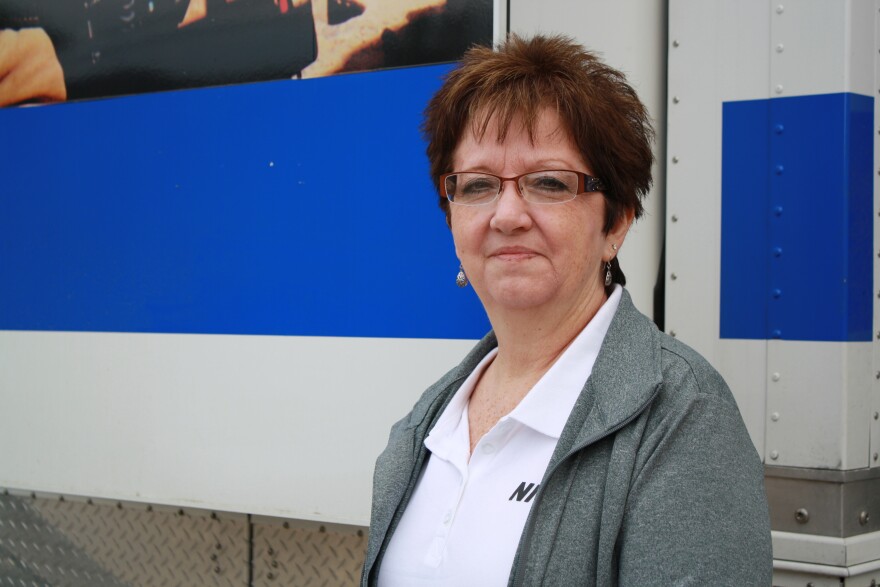The Centers for Disease Control & Prevention is offering black lung screenings across the West.
The National Institute of Occupational Health and Safety, a division of the CDC, has a mobile unit that travels around the United States to screen coal miners for the disease.
The unit recently stopped in Colorado.
Coal Workers Pneumoconiosis, better known as black lung disease, is caused by the inhalation of coal mine dust.
Anita Wolfe, a public health analyst for the institute, screens coal miners for the black lung.
“A miner with severe Pneumoconiosis can get the air in but they consciously have to make an effort to get the air out," Wolfe said. "So if you are talking with a miner who has severe Pneumoconiosis you will hear [congested breathing] in and [heavy breath out].”
Black lung disease is irreversible, but it's also preventable.
"We have to really work with not just the miners but the mine operators in making that sure dust levels are kept where they are suppose to be, that water sprays are used at the face of the mine, that the ventilation curtains are hung, and that everything is within the regulations and maybe even more than the regulations call for to keep our miners from dying from this disease," Wolfe said.
Under the Federal Mine and Safety Act, coal mine operators have to offer new miners working in underground coal mines a chest X-ray and physical exam. The X-ray is used by doctors to establish a miner’s health at the start of their career. Federal regulations also require mine operators to offer seasoned underground coal miners chest X-rays every five years.
Wolfe said in the early stages of the disease people don’t often have visible symptoms.
“That’s another reason we say to do screening early because often through...the breathing test or through the X-ray that’s taken we detect disease before the miner even has any symptoms," she said. " We’ll call them and say you have the beginning stages of simple Pneumoconiosis. And they’re like, “I feel fine,” and were like that’s why we’re glad you came early."
As the disease progresses miners can become short of breath, develop a severe cough, and they might notice their finger nails turning blue because of a lack of oxygen.
Wolfe said when a miner dies of black lung disease they essentially suffocate.
The mobile screening unit recently stopped in Paonia, Colorado because of its proximity to three coal mines.

Jason Timbreza, a fourth-generation miner who works at the Bowie Coal Mine, got examined at the unit. Timbreza said he's been getting screened for black lung since he started working in the industry 20 years ago.
“I would recommend that all miners anytime that the opportunity arises to take advantage of it and get your screening done," he said. "One of the keys to any disease is early detection.”
Arnold Kirstatter, who also works at the Bowie mine, said he came to the screening to make sure he doesn’t have black lung disease. Kirstatter said he's been working in the industry for 34 years.
“You always have that in the back of your mind that you could get black lung," he said "And you try to avoid it by wearing a mask in any dust situations...and you use all the precautions you can not to get black lung.”
The free exams are open to anyone who has ever worked in a coal mine. The confidential screenings include a breathing test and chest x-ray.
The exam takes about a half-hour. The mobile unit will also stop in New Mexico, Arizona and Utah.
The CDC said one in every 20 miners who are screened through its programs have black lung disease.
Wolfe said she and her mobile team examine about 2,500 miners a year.
Wolfe also has a personal connection to the disease. Her father was a coal miner in West Virginia and died from black lung at the age of 83.
“My father started mining in the 1930’s," she said. "He started working at a coal mine when he was 12-years-old. And, he was the mule boy, he took care of the mules for the miners. He loved it and worked his way up as he said to where he was drilling in the coal seam and loading the dynamite, and running as the coal came out of the rib and was hand loading coal."

Wolfe said her father worked in a time when regulations were not as strict as they are today.
"And he ended up with very severe black lung disease and died from black lung disease," she said. "For the last year of his life we kept him at home and we took care of him. And I was holding his hand when he died. It’s not a disease that I ever want to see anybody else die from because it's just horrible to watch someone suffocate.”
According to the CDC, between 1968 and 2010 more than 76,000 died from black lung disease.





